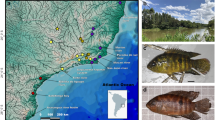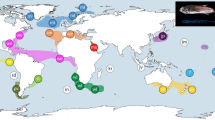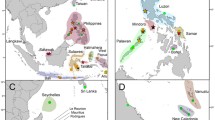Abstract
Antarctic notothenioids represent one of the few strongly supported examples of adaptive radiation in marine fishes. The extent of population connectivity and structure is unknown for many species, thereby limiting our understanding of the factors that underlie speciation dynamics in this radiation. Here, we assess the population structure of the widespread species Cryodraco antarcticus and its sister species Cryodraco atkinsoni, whose taxonomic status is currently debated. Combining both population genetic and phylogenetic approaches to species delimitation, we provide evidence that C. atkinsoni is a distinct species. Our analyses show that C. atkinsoni and C. antarcticus are recently diverged sister lineages, and the two species differ with regard to patterns of population structure. A systematic and accurate account of species diversity is a critical prerequisite for investigations into the complex processes that underlie the history of speciation in the notothenioid adaptive radiation.



Similar content being viewed by others
References
Allcock AL et al (2011) Cryptic speciation and the circumpolarity debate: a case study on endemic Southern Ocean octopuses using the COI barcode of life. Deep-Sea Res Part II 58:242–249
Baele G, Lemey P, Bedford T, Rambaut A, Suchard MA, Alekseyenko AV (2012) Improving the accuracy of demographic and molecular clock model comparison while accommodating phylogenetic uncertainty. Mol Biol Evol 29:2157–2167
Baele G, Li WLS, Drummond AJ, Suchard MA, Lemey P (2013) Accurate model selection of relaxed molecular clocks in Bayesian phylogenetics. Mol Biol Evol 30:239–243
Balushkin AV (1996) Similarity of family Channichthyidae (Notothenioidei, Perciformes), with remarks on the species composition of the family and the description of a new species from the Kerguelen Archipelago. J Ichthyol 36:1–10
Chow S, Hazama K (1998) Universal PCR primers for S7 ribosomal protein gene introns in fish. Mol Ecol 7:1255–1256
Clement M, Posada D, Crandall KA (2000) TCS: a computer program to estimate gene genealogies. Mol Ecol 9:1657–1659
Cziko PA, Cheng C-HC (2006) A new species of nototheniid (Perciformes: Notothenioidei) fish from McMurdo Sound. Antarct Copeia 2006:752–759
Damerau M, Matschiner M, Salzburger W, Hanel R (2012) Comparative population genetics of seven notothenioid fish species reveals high levels of gene flow along ocean currents in the southern Scotia Arc. Antarct Polar Biol 35:1073–1086
Dettaï A et al (2011) The actinopterygian diversity of the CEAMARC cruises: barcoding and molecular taxonomy as a multi-level tool for new findings. Deep-Sea Res Part II 58:250–263
Drummond AJ, Rambaut A (2007) BEAST: Bayesian evolutionary analysis by sampling trees. BMC Evol Biol 7:214
Drummond AJ, Ho SYW, Phillips MJ, Rambaut A (2006) Relaxed phylogenetics and dating with confidence. PLoS Biol 4:699–710
Earl DA (2012) STRUCTURE HARVESTER: a website and program for visualizing STRUCTURE output and implementing the Evanno method. Conserv Genet Res 4:359–361
Eastman JT (1985) The evolution of neutrally buoyant notothenioid fishes: their specializations and potential interactions in the Antarctic marine food web. In: Siegfried WR, Condy PR, Laws RM (eds) Antarctic nutrient cycles and food webs. Springer, Berlin, pp 430–436
Eastman JT (1993) Antarctic fish biology: evolution in a unique environment. Academic Press, San Diego
Eastman JT (2005) The nature of the diversity of Antarctic fishes. Polar Biol 28:93–107
Eastman JT, Clarke A (1998) A comparison of adaptive radiations of Antarctic fish with those of non-Antarctic fish. In: Di Prisco G, Pisano E, Clarke A (eds) Fishes of Antarctica: a biological overview. Springer, Milano, pp 3–26
Edgar RC (2004) MUSCLE: multiple sequence alignment with high accuracy and high throughput. Nucleic Acids Res 32:1792–1797
Evanno G, Regnaut S, Goudet J (2005) Detecting the number of clusters of individuals using the software STRUCTURE: a simulation study. Mol Ecol 14:2611–2620
Eytan RI, Hellberg ME (2010) Nuclear and mitochondrial sequence data reveal and conceal different demographic histories and population genetic processes in Caribbean reef fishes. Evolution 64:3380–3397
Eytan RI, Hayes M, Arbour-Reily P, Miller M, Hellberg ME (2009) Nuclear sequences reveal mid-range isolation of an imperilled deep-water coral population. Mol Ecol 18:2375–2389
Falush D, Stephens M, Pritchard JK (2007) Inference of population structure using multilocus genotype data: dominant markers and null alleles. Mol Ecol Notes 7:574–578
Flot JF (2010) SeqPHASE: a web tool for interconverting PHASE input/output files and FASTA sequence alignments. Mol Ecol Resour 10:162–166
Fraser CI, Nikula R, Ruzzante DE, Waters JM (2012) Poleward bound: biological impacts of Southern Hemisphere glaciation. Trends Ecol Evol 27:462–471
Hein J, Schierup MH, Wiuf C (2005) Gene genealogies, variation and evolution: a primer in coalescent theory. Oxford University Press, Oxford
Hubert N, Delrieu-Trottin E, Irisson J-O, Meyer C, Planes S (2010) Identifying coral reef fish larvae through DNA barcoding: a test case with the families Acanthuridae and Holocentridae. Mol Phylogenet Evol 55:1195–1203
Huelsenbeck JP, Andolfatto P, Huelsenbeck ET (2011) Structurama: Bayesian inference of population structure. Evol Bioinf Online 7:55
Hureau JC (1985) Nototheniidae. In: Fischer W, Hureau JC (eds) FAO species identification sheets for fishery purposes: Southern Ocean (Fishing areas 48, 58 and 88) (CCAMLR Convention Area), vol 2. FAO, Rome, pp 233–471
Ivanova NV, Zemlak TS, Hanner RH, Hebert PD (2007) Universal primer cocktails for fish DNA barcoding. Mol Ecol Notes 7:544–548
Iwami T, Kock K-H (1990) Channichthyidae. In: Gon O, Heemstra PC (eds) Fishes of the Southern Ocean. J.L.B. Smith Institute of Ichthyology, Grahamstown, pp 381–399
Jombart T (2008) adegenet: a R package for the multivariate analysis of genetic markers. Bioinformatics 24:1403–1405
Jombart T, Ahmed I (2011) adegenet 1.3-1: new tools for the analysis of genome-wide SNP data. Bioinformatics 27:3070–3071
Jombart T, Devillard S, Balloux F (2010) Discriminant analysis of principal components: a new method for the analysis of genetically structured populations. BMC Genet 11:94
Kass RE, Raftery AE (1995) Bayes factors. J Am Stat Assoc 90:773–795
Kearse M et al (2012) Geneious Basic: an integrated and extendable desktop software platform for the organization and analysis of sequence data. Bioinformatics 28:1647–1649
Kocher TD, Conroy JA, McKaye KR, Stauffer JR, Lockwood SF (1995) Evolution of NADH dehydrogenase subunit 2 in east African cichlid fish. Mol Phylogenet Evol 4:420–432
Kock KH (1992) Antarctic fish and fisheries. Studies in polar research. Cambridge University Press, Cambridge
Kock KH (2005) Antarctic icefishes (Channichthyidae): a unique family of fishes. A review, part I. Polar Biol 28:862–895
Kock K-H, Jones CD (2002) The biology of the icefish Cryodraco antarcticus Dollo, 1900 (Pisces, Channichthyidae) in the southern Scotia Arc (Antarctica). Polar Biol 25:416–424
Kock KH, Jones CD (2005) Fish stocks in the southern Scotia Arc region—a review and prospects for future research. Rev Fish Sci 13:75–108
La Mesa M, Vacchi M, Iwami T, Eastman JT (2002) Taxonomic studies of the Antarctic icefish genus Cryodraco Dollo, 1900 (Notothenioidei: Channichthyidae). Polar Biol 25:384–390
La Mesa M, Eastman JT, Vacchi M (2004) The role of notothenioid fish in the food web of the Ross Sea shelf waters: a review. Polar Biol 27:321–338
Lanfear R, Calcott B, Ho SYW, Guindon S (2012) PartitionFinder: combined selection of partitioning schemes and substitution models for phylogenetic analyses. Mol Biol Evol 29:1695–1701
Lautredou A-C, Bonillo C, Denys G, Cruaud C, Ozouf-Costaz C, Lecointre G, Dettai A (2010) Molecular taxonomy and identification within the Antarctic genus Trematomus (Notothenioidei, Teleostei): how valuable is barcoding with COI? Polar Sci 4:333–352
Lopez JA, Chen WJ, Ortí G (2004) Esociform phylogeny. Copeia 2004:449–464
Marino I et al (2013) Evidence for past and present hybridization in three Antarctic icefish species provides new perspectives on an evolutionary radiation. Mol Ecol 22:5148–5161
Matschiner M, Hanel R, Salzburger W (2009) Gene flow by larval dispersal in the Antarctic notothenioid fish Gobionotothen gibberifrons. Mol Ecol 18:2574–2587
Matschiner M, Hanel R, Salzburger W (2011) On the origin and trigger of the notothenioid adaptive radiation. Plos ONE 6. doi:10.1371/journal.pone.0018911
Miller RG (1993) A history and atlas of the fishes of the Antarctic Ocean. Foresta Institute for Ocean and Mountain Studies, Carson City
Near TJ et al (2012) Ancient climate change, antifreeze, and the evolutionary diversification of Antarctic fishes. Proc Natl Acad Sci USA 109:3434–3439
Norman JR (1938) Coast fishes. Part III. The Antarctic zone. Discov Rep 18:1–104
Papetti C, Pujolar JM, Mezzavilla M, La Mesa M, Rock J, Zane L, Patarnello T (2012) Population genetic structure and gene flow patterns between populations of the Antarctic icefish Chionodraco rastrospinosus. J Biogeogr 39:1361–1372
Paradis E (2010) pegas: an R package for population genetics with an integrated-modular approach. Bioinformatics 26:419–420
Pegg GG, Sinclair B, Briskey L, Aspden WJ (2006) MtDNA barcode identification of fish larvae in the southern Great Barrier Reef-Australia. Sci Mar 70:7–12
Pons J et al (2006) Sequence-based species delimitation for the DNA taxonomy of undescribed insects. Syst Biol 55:595–609
Pritchard JK, Stephens M, Donnelly P (2000) Inference of population structure using multilocus genotype data. Genetics 155:945–959
Rambaut A, Drummond AJ (2003) Tracer, MCMC trace analysis package, 1.5 edn. http://beast.bio.ed.ac.uk/Tracer
Regan CT (1913) The Antarctic fishes of the Scottish National Antarctic Expedition. Trans R Soc Edinb 49:229–292
Regan CT (1914) Fishes. British Antarctic Terra Nova Expedition, 1910, natural history report. Zoology 1:1–54
Reid NM, Carstens BC (2012) Phylogenetic estimation error can decrease the accuracy of species delimitation: a Bayesian implementation of the general mixed Yule-coalescent model. BMC Evol Biol 12:196
Rock J, Costa F, Walker D, North A, Hutchinson W, Carvalho G (2008) DNA barcodes of fish of the Scotia Sea, Antarctica indicate priority groups for taxonomic and systematics focus. Antarct Sci 20:253–262
Rutschmann S, Matschiner M, Damerau M, Muschick M, Lehmann MF, Hanel R, Salzburger W (2011) Parallel ecological diversification in Antarctic notothenioid fishes as evidence for adaptive radiation. Mol Ecol 20:4707–4721
Shandikov GA, Eakin RR (2013) Pogonophryne neyelovi, a new species of Antarctic short-barbeled plunderfish (Perciformes, Notothenioidei, Artedidraconidae) from the deep Ross Sea. ZooKeys 296:59–77
Shandikov GA, Eakin RR, Usachev S (2013) Pogonophryne tronio, a new species of Antarctic short-barbeled plunderfish (Perciformes: Notothenioidei: Artedidraconidae) from the deep Ross Sea with new data on Pogonophryne brevibarbata. Polar Biol 36:273–289
Smith PJ, Steinke D, Dettai A, McMillan P, Welsford D, Stewart A, Ward RD (2012) DNA barcodes and species identifications in Ross Sea and Southern Ocean fishes. Polar Biol 35:1297–1310
Spodareva V, Balushkin A (2014) Description of a new species of plunderfish of genus Pogonophryne (Perciformes: Artedidraconidae) from the Bransfield Strait (Antarctica) with a key for the identification of species of the group “marmorata”. J Ichthyol 54:1–6
Steinke D, Zemlak TS, Hebert PD (2009) Barcoding Nemo: DNA-based identifications for the ornamental fish trade. PLoS ONE 4:e6300
Stephens M, Donnelly P (2003) A comparison of bayesian methods for haplotype reconstruction from population genotype data. Am J Hum Genet 73:1162–1169
Stephens M, Scheet P (2005) Accounting for decay of linkage disequilibrium in haplotype inference and missing-data imputation. Am J Hum Genet 76:449–462
Stephens M, Smith NJ, Donnelly P (2001) A new statistical method for haplotype reconstruction from population data. Am J Hum Genet 68:978–989
Tajima F (1989) Statistical method for testing the neutral mutation hypothesis by DNA polymorphism. Genetics 123:585–595
Vacchi M, La Mesa M (1997) Morphometric analysis of Cryodraco specimens (Notothenioidei: Channichthyidae) from Terra Nova Bay, Ross Sea. Cybium 21:363–368
Valdez-Moreno M, Quintal-Lizama C, Gómez-Lozano R, del Carmen G-RM (2012) Monitoring an alien invasion: DNA barcoding and the identification of lionfish and their prey on coral reefs of the Mexican Caribbean. PLoS ONE 7:e36636
Villesen P (2007) FaBox: an online toolbox for fasta sequences. Mol Ecol Notes 7:965–968
Waite ER (1916) Fishes Australasian Antarctic Expedition 1911–1914. Sci Rep Ser C Zool Bot 3:3–92
Ward RD, Hanner R, Hebert PD (2009) The campaign to DNA barcode all fishes, FISH-BOL. J Fish Biol 74:329–356
Young EF et al (2015) Oceanography and life history predict contrasting genetic population structure in two Antarctic fish species. Evol Appl 8:486–509
Zane L et al (2006) Demographic history and population structure of the Antarctic silverfish Pleuragramma antarcticum. Mol Ecol 15:4499–4511
Acknowledgments
Fieldwork was facilitated through the United States Antarctic Marine Living Resources Program and the officers and crew of the RV Yuzhmorgeologia, the 2004 ICEFISH cruise aboard the RVIB Nathaniel B. Palmer, and the 2008 IPY/CAML expedition aboard the RV Tangaroa funded by the New Zealand Government. Specimens and data collected by and made available through the New Zealand International Polar Year-Census of Antarctic Marine Life Project are gratefully acknowledged. Field and laboratory support was provided by H. W. Detrich, J. Kendrick, K.-H. Kock, K. L. Kuhn, and J. A. Moore. This research was funded from a NSF grant awarded to T.J.N. (PLR-1341661). All sequence alignment and analysis files used in this study have been archived on Zenodo (DOI:10.5281/zenodo.35673).
Author information
Authors and Affiliations
Corresponding author
Electronic supplementary material
Below is the link to the electronic supplementary material.
Rights and permissions
About this article
Cite this article
Dornburg, A., Eytan, R.I., Federman, S. et al. Molecular data support the existence of two species of the Antarctic fish genus Cryodraco (Channichthyidae). Polar Biol 39, 1369–1379 (2016). https://doi.org/10.1007/s00300-015-1859-9
Received:
Revised:
Accepted:
Published:
Issue Date:
DOI: https://doi.org/10.1007/s00300-015-1859-9




